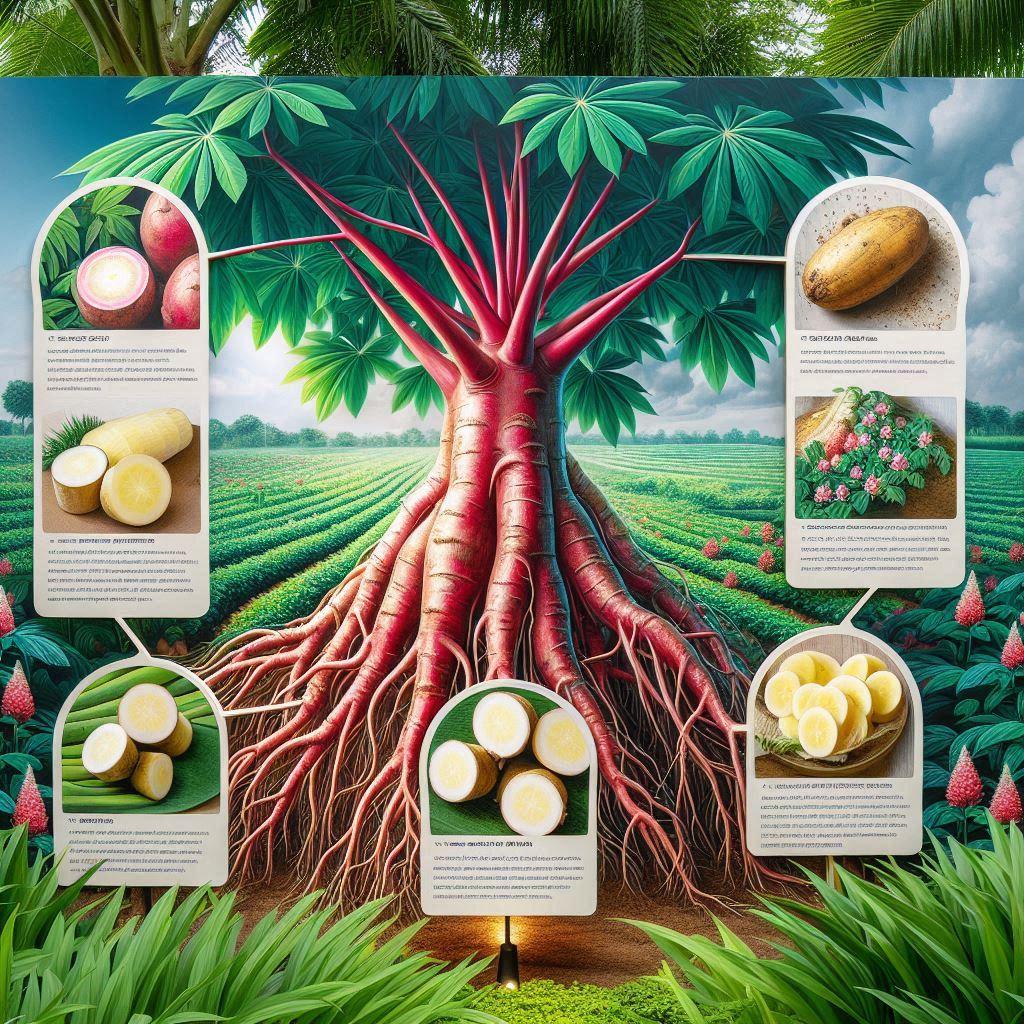
Introduction to Cassava
Cassava, a starchy root vegetable native to South America, is a vital crop in tropical and subtropical regions worldwide. Known for its resilience in poor soil conditions and resistance to drought, cassava plays a crucial role in global agriculture by providing a reliable source of carbohydrates for millions of people. It is the third-largest source of food carbohydrates in the tropics, following rice and maize, making it an essential staple food for over 800 million individuals globally. In addition to its significance as a staple food, cassava is highly versatile in culinary applications. It can be processed into various forms such as flour, chips, or tapioca pearls used widely across different cuisines. This adaptability not only supports diverse diets but also drives economic growth through local and international trade markets. As both a food security crop and an economic asset, cassava continues to hold immense importance in addressing hunger challenges while fostering agricultural development around the world.
Nutritional Profile
Cassava is a staple food in many tropical regions, known for its rich carbohydrate content, particularly starch, making it an essential energy source for millions of people. However, its nutritional profile extends beyond carbohydrates; it also contains small amounts of protein and fat. When compared to other staple foods like rice and potatoes, cassava generally provides fewer proteins but offers a higher calorie count due to its dense starch composition. Cassava is also notable for its vitamin C content, which can contribute to antioxidant defenses and immune function. While it lacks the variety of micronutrients found in cereals like wheat or corn, it serves as a valuable dietary component when combined with nutrient-dense foods such as legumes or vegetables to create a balanced diet. Understanding cassava’s nutritional strengths and limitations helps in planning diets that maximize health benefits while ensuring adequate intake of essential nutrients across diverse populations relying on this versatile tuber.
Origin and History
Cassava, a starchy root crop native to South America, has a rich historical background that stretches back thousands of years. Its cultivation is believed to have originated in the Amazon basin, where indigenous populations first domesticated the plant and developed methods for processing its roots into edible forms. As early explorers and traders began traversing continents, cassava was introduced to other regions, notably Africa and Asia, where it adapted well to tropical climates and became a staple food source. Today, cassava is primarily grown in countries near the equator due to its resilience in poor soil conditions and ability to withstand droughts. Its spread across various geographical regions has been facilitated by its versatility as both a subsistence crop for local populations and an industrial raw material used in products like tapioca and biofuels. Understanding this historical journey of cassava highlights not only its agricultural significance but also its vital role in sustaining communities around the world through centuries of cultivation.
Varieties of Cassava
Cassava, a staple crop in many tropical regions, comes in two main varieties: sweet and bitter cassava. The difference between the two lies primarily in their cyanogenic glucoside content, which is higher in bitter cassava. This makes sweet cassava safer to consume with minimal preparation, while bitter cassava requires more extensive processing to eliminate toxins. Popular cultivars of sweet cassava include ‘Mcol 1505’ and ‘Rayong 9’, which are often favored for direct consumption or for making products like tapioca pearls and starch. Bitter cassava varieties such as ‘IITA-TMS-IBA980505’ are typically used in industrial applications or fermented products due to the need for detoxification before consumption. Understanding these differences is crucial for determining how each type can be safely utilized, whether it be in culinary dishes or various industrial processes, highlighting the versatility and importance of this vital crop across different sectors.
Economic Importance
Cassava plays a crucial role in food security, particularly in tropical regions where it serves as a staple for millions. Its resilience to harsh environmental conditions makes it an invaluable crop in areas prone to drought and poor soil quality, ensuring a steady food supply even in challenging times. Economically, cassava has significant impacts on both local and global markets. At the local level, it provides income for smallholder farmers who sell fresh roots or processed products like flour and starch. These products are not only vital for domestic consumption but also have export potential, contributing to national economies. On the global stage, cassava is increasingly being recognized as a versatile raw material for industries ranging from food processing to biofuels, expanding its market reach and economic significance. As demand continues to grow worldwide, cassava’s contribution to economic stability and growth is becoming more pronounced, highlighting its importance as both a food security staple and an economic driver.
Unique Uses of Cassava
Cassava, a versatile root crop, has found unique applications far beyond its traditional uses in flour and biofuel production. In recent years, innovative industrial applications have emerged that leverage cassava’s inherent properties. One such use is in the production of biodegradable plastics; researchers have discovered that the starch from cassava can be used to create eco-friendly packaging materials that decompose more quickly than conventional plastics. Additionally, cassava is being explored as a raw material for producing adhesives and glues due to its strong binding properties, offering an alternative to petroleum-based products. The textile industry has also taken note of cassava’s potential by utilizing its starch in fabric finishing processes to enhance texture and durability. Furthermore, cassava plays a role in the pharmaceutical sector where its derivatives are used as excipients—substances formulated alongside active ingredients of medications—to aid drug delivery. These innovations highlight cassava’s potential to contribute significantly across various industries beyond food consumption, underscoring its importance as a sustainable resource with diverse industrial applications.
Environmental Adaptability
Cassava, a resilient root crop, demonstrates remarkable environmental adaptability, enabling it to thrive in poor soils and a range of climates. This adaptability is primarily due to its robust root system and ability to tolerate drought conditions, which allows it to grow in regions where other crops might fail. Cassava’s cultivation requires minimal inputs such as fertilizers or pesticides, making it an ideal crop for farmers in resource-limited settings. Furthermore, its versatility extends beyond growth conditions; cassava can be processed into various products like flour and starch, providing multiple food sources and economic opportunities for communities. As the world grapples with increasing food scarcity issues due to climate change and population growth, cassava presents a viable solution by offering a reliable food source that can sustain large populations even in adverse environmental conditions. By investing in cassava cultivation and improving processing techniques, we can enhance food security and support sustainable agricultural practices globally. Its resilience not only highlights the potential of underutilized crops but also underscores the importance of diversifying agricultural systems to meet future challenges.
Preparation and Cooking Methods
Understanding the preparation and cooking methods for cassava is crucial, as this root vegetable requires careful handling due to its naturally occurring cyanogenic compounds. Traditional techniques often involve peeling, soaking, and fermenting cassava to reduce these toxins. Methods such as boiling, steaming, or grating followed by sun-drying in regions like Africa and South America have been passed down through generations to ensure safety. Modern cooking techniques also emphasize safety while introducing convenience; for example, pressure cooking can effectively neutralize harmful substances in shorter times. Regardless of the method chosen, it is essential to adhere to recommended preparation practices to prevent health risks associated with improper consumption of cassava. Additionally, consuming commercially processed cassava products like flour and tapioca pearls offers a safe alternative as they undergo rigorous detoxification processes during manufacturing. By combining tradition with modern advancements in food safety and preparation techniques, individuals can enjoy the nutritional benefits of cassava without compromising their well-being.
Health Benefits and Risks
Cassava is a starchy root vegetable that offers several potential health benefits when incorporated into a balanced diet. It is rich in carbohydrates, providing an excellent source of energy, and contains essential nutrients such as vitamin C, thiamine, riboflavin, and niacin. Furthermore, cassava can be a valuable dietary staple for those seeking gluten-free alternatives due to its natural lack of gluten. However, consuming cassava also comes with certain risks if it is not prepared correctly. The root contains cyanogenic compounds that can produce hydrogen cyanide when improperly processed or consumed raw. This toxicity poses serious health risks including acute poisoning, which can lead to symptoms such as dizziness, headaches, nausea, and in severe cases, even death. To mitigate these risks, it is crucial to peel and thoroughly cook cassava before consumption to break down the harmful compounds effectively. By understanding both the benefits and risks associated with cassava consumption and following safe preparation methods, individuals can enjoy this nutritious food while safeguarding their health.
Fun Facts and Trivia
Cassava, a staple food for millions worldwide, has fascinating ties to popular culture and some surprising statistics that highlight its significance. Known for its adaptability and resilience, cassava has been featured in various cultural contexts, including folklore and traditional cuisine. For instance, in many African countries, cassava is not only a dietary staple but also plays a role in local festivals and celebrations, symbolizing fertility and sustenance. Interestingly, cassava consumption statistics reveal that it provides more than one-third of the total calories consumed by over 800 million people globally. This humble root crop ranks as the third-largest source of carbohydrates in tropical regions after rice and maize. Furthermore, Brazil hosts an annual festival celebrating ‘farofa,’ a dish made from toasted cassava flour—a testament to the plant’s cultural importance. As these fun facts demonstrate, cassava’s influence extends far beyond nutrition; it is deeply woven into the fabric of community life across continents.
Conclusion
In conclusion, cassava stands as a crucial crop with far-reaching implications for both nutrition and the global economy. As a staple food for millions of people, particularly in developing regions, it provides essential carbohydrates and serves as a vital source of calories. Its resilience to harsh growing conditions makes it an indispensable resource in areas susceptible to climate variability. Economically, cassava’s versatility extends beyond direct consumption; it is also used in producing various products such as flour, animal feed, and even biofuels, which contribute significantly to local and international markets. Despite its importance, there remains a pressing need to raise awareness about cassava’s role in sustaining livelihoods and enhancing food security. By increasing understanding of its benefits and potential applications, stakeholders can foster more sustainable agricultural practices and leverage cassava’s full potential for advancing economic development. Recognizing cassava’s multifaceted contributions will ensure that this invaluable crop continues to support communities worldwide while promoting nutritional health and economic resilience.






